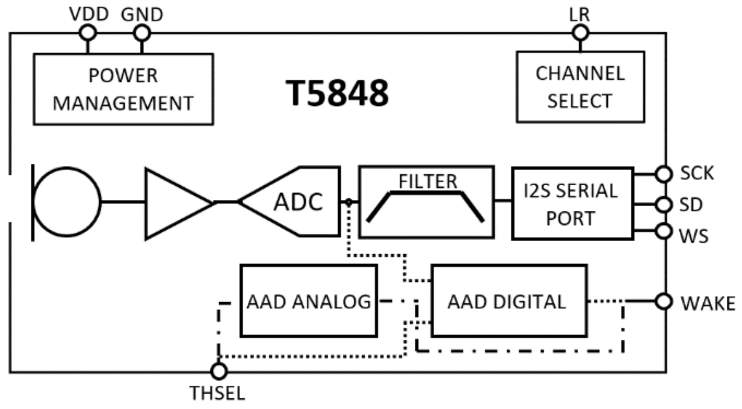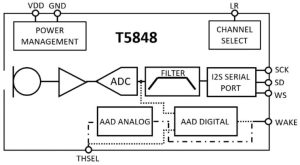

Called T5848, it has a I2S interface and an ‘acoustic activity detect’ (AAD) function with its own outputs. Vital statistics of its surface-mount bottom acoustic port package are 3.5 x 2.65 x 0.98mm.
Three traditional mems microphone modes are selected by the externally-applied clock frequency:
High-quality mode (2 – 3.7MHz) offers −37dB±1dB full-scale sensitivity (1kHz, 94dB SPL (sound pressure level)), 68 dBA SNR (signal-to-noise ratio) and an AOP (acoustic overload point) of 133dB SPL for a consumption of 330µA from 1.8V (supply range is 1.62 to 1.98V).
Low-power mode (600 – 800kHz) reduces consumption to 130µA by dropping the clock to . Performance falls to −26±1 dB FS sensitivity, 64dBA SNR and 119dB SPL.
Sleep mode (<200kHz) consumes only 9µA, which drops to an 800nA ‘off’ mode when clocking is stopped.
“The exceptional SNR of the T5848 ensures AI systems receive high-quality input, even in noisy surroundings where keywords or voice commands must be distinguished from irrelevant background noise,” according to the company.
AAD activity detection is an extension on top of the low-power and sleep modes, initiated by writing to the ‘THSEL’ pad and sometimes altering the clocking frequency – the data sheet is your friend here.
There are two digital and one analogue AAD modes, that offer different wake sensitivities and result in entering different modes after waking. The chip also sets the ‘Wake’ pad high all the time activity passes the detection threshold.
Analogue AAD mode is the lowest power wake-able state, costing only 20µA.
TDK is demonstrating the microphone and its AAD capability at Sensors Converge today and tomorrow (25, 26 June 12024) at the Santa Clara Convention Center on booth 920, or find the T5848 on this web page and its data sheet here.
Other potential applications are in TV remote controls, home security, action cameras, earbuds, smart speakers and action cameras.







